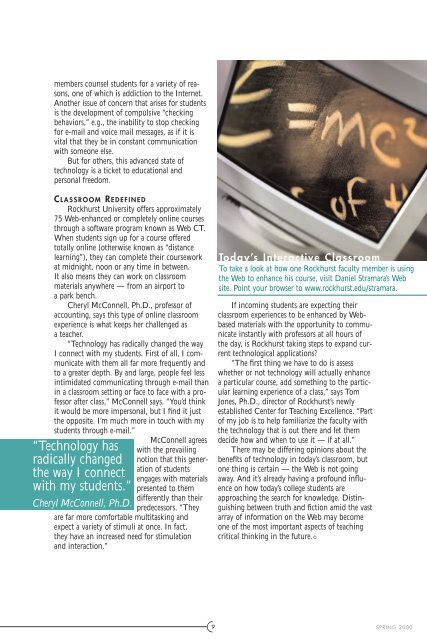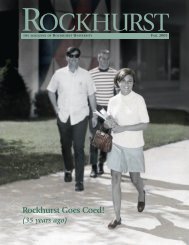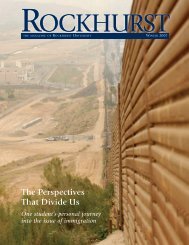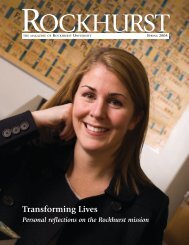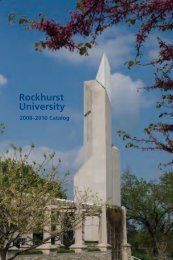Being Human - Rockhurst University
Being Human - Rockhurst University
Being Human - Rockhurst University
- No tags were found...
You also want an ePaper? Increase the reach of your titles
YUMPU automatically turns print PDFs into web optimized ePapers that Google loves.
members counsel students for a variety of reasons,one of which is addiction to the Internet.Another issue of concern that arises for studentsis the development of compulsive “checkingbehaviors,” e.g., the inability to stop checkingfor e-mail and voice mail messages, as if it isvital that they be in constant communicationwith someone else.But for others, this advanced state oftechnology is a ticket to educational andpersonal freedom.C LASSROOM R EDEFINED<strong>Rockhurst</strong> <strong>University</strong> offers approximately75 Web-enhanced or completely online coursesthrough a software program known as Web CT.When students sign up for a course offeredtotally online (otherwise known as “distancelearning”), they can complete their courseworkat midnight, noon or any time in between.It also means they can work on classroommaterials anywhere — from an airport toa park bench.Cheryl McConnell, Ph.D., professor ofaccounting, says this type of online classroomexperience is what keeps her challenged asa teacher.“Technology has radically changed the wayI connect with my students. First of all, I communicatewith them all far more frequently andto a greater depth. By and large, people feel lessintimidated communicating through e-mail thanin a classroom setting or face to face with a professorafter class,” McConnell says. “You’d thinkit would be more impersonal, but I find it justthe opposite. I’m much more in touch with mystudents through e-mail.”McConnell agreeswith the prevailingnotion that this generationof studentsengages with materialspresented to themdifferently than theirpredecessors. “Theyare far more comfortable multitasking andexpect a variety of stimuli at once. In fact,they have an increased need for stimulationand interaction.”“Technology hasradically changedthe way I connectwith my students.”Cheryl McConnell, Ph.D.Today’s Interactive ClassroomTo take a look at how one <strong>Rockhurst</strong> faculty member is usingthe Web to enhance his course, visit Daniel Stramara’s Website. Point your browser to www.rockhurst.edu/stramara.If incoming students are expecting theirclassroom experiences to be enhanced by Webbasedmaterials with the opportunity to communicateinstantly with professors at all hours ofthe day, is <strong>Rockhurst</strong> taking steps to expand currenttechnological applications?“The first thing we have to do is assesswhether or not technology will actually enhancea particular course, add something to the particularlearning experience of a class,” says TomJones, Ph.D., director of <strong>Rockhurst</strong>’s newlyestablished Center for Teaching Excellence. “Partof my job is to help familiarize the faculty withthe technology that is out there and let themdecide how and when to use it — if at all.”There may be differing opinions about thebenefits of technology in today’s classroom, butone thing is certain — the Web is not goingaway. And it’s already having a profound influenceon how today’s college students areapproaching the search for knowledge. Distinguishingbetween truth and fiction amid the vastarray of information on the Web may becomeone of the most important aspects of teachingcritical thinking in the future.9 SPRING 2000


